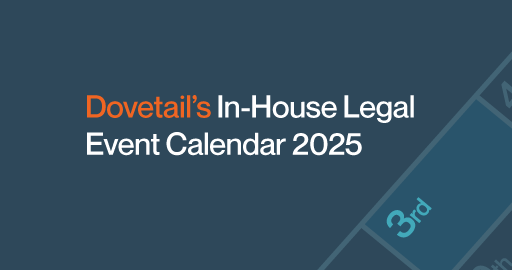
Dovetail’s In-House Legal Events Calendar 2025
All the in-house legal events this year in one place.
21st Nov 2022

Managing Director
The team at Dovetail: Andrew Murdoch, Imogen Spouse and Charlie Smirl, had the pleasure of attending and exhibiting at the 2022 ACC In-House Legal National Conference, from 16th to 18th November, in sunny Brisbane.
The team at Dovetail: Andrew Murdoch, Imogen Spouse and Charlie Smirl, had the pleasure of attending and exhibiting at the 2022 ACC In-House Legal National Conference, from 16th to 18th November, in sunny Brisbane.
Here’s a link to the Program and below is a compilation of the key messages we heard from some of the sessions at the event:
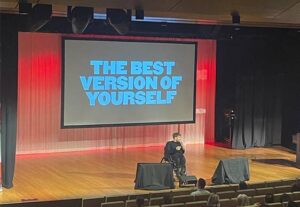
Dylan Alcott OA, Paralympic & World Champion – Inspirational Speaker
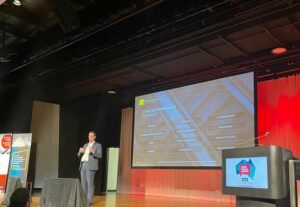
Campbell Jackson – EY, with insights from the client’s perspective from Kate Carlile – Toll, and Malcolm Haack – Orica.
Commissioner Jennifer Hunt – Fair Work Commission, Neil Henderson, Secretary – Australian Services Union, Julie O’Brien, General Counsel – Australian Human Rights Commission and Bernadette Doyle, Manager, Legal Counsel – Seqwater
To assist in-house counsel getting ready for employment law changes coming under Secure Jobs, Better Pay Bill, the panel discussion touched on:
Shaun Plant, Chief Legal Officer at LawVu
Why do people move in-house: variety of work / from start to finish / directly see the results.
In-house legal function is maintaining the machine. External legal is fixing a broken component of the machine.
Frances Hoskins, General Counsel at the Australian Institute of Marine Science, and Andrew Paloni, Special Counsel – Major Projects at the Australian Institute of Marine Science
Finding engaging and creative ways to communicate legal matters to non-lawyers within the business is vital as an in-house lawyer. Making information that would usually be boring, interesting starts by asking two questions: who is my audience? And what do I want or need them to know?
Good communication is a gift, when you are communicating with others, especially as an in-house lawyer, you want to ensure people feel empowered, smart, and confident. Clarity, accessible language and communication will empower non-lawyers within the business to ask questions and act on legal advice. The Communication Toolbox is a great resource to inspire creativity as in-house counsel.
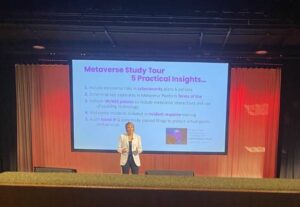
Schellie-Jayne Price, Legal Technology and Innovation Chair – ACC Australia
The metaverse fuses our digital and physical life. It’s the future, but it’s currently operating in a legally complex grey area. As the virtual world becomes more sophisticated and intertwined with our everyday lives, influencing and advising on the grey areas surrounding law in the metaverse will be paramount for in-house lawyers.
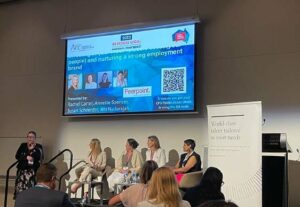
Panel: Rachel Carter – PeerPoint, Annette Spencer, General Counsel – Barrenjoey, Susan Schenieder, Chief Legal & Risk Officer – Virgin, Niti Nadarajah, Freelance General Counsel and Coach – Legal by Niti
The Honourable Justice Martin Daubney AM

Dr Katherine King, Chief Executive Officer – Dazychain, Mark Flint, General Counsel – Geocon, Kirrilly Gordon, Group Commercial and Legal Manager – SEE Group, Gemma O’Meara, Senior Legal Counsel – Fitness Lifestyle Group
Technology has been an important component in getting through the pandemic. We’ve moved from letter, to fax, to e-mail. Technology can be used to demonstrate to the business what legal is doing and for the legal team to understand the volume of work they have. Creates one source of truth.
One way to use technology is to have a central intake system for all legal issues. Business was initially resistant but now works well – but need consistency and all team members to push back on business from going around the central intake. Have an open-door policy for business to connect with legal and people can call. It helps to have executive endorsement when implementing new technologies.
When implementing new technology, break it down, get collaboration, and have a quick win initially. Also do research, look at cost and build a relationship with IT.
Is technology a cause or solution to misery? Both – depends how it’s used.
Dr Catherine Ball, Scientific Futurist
We’re in Industrial Revolution 5.0. Will go for 10 years. 4.0 was pre covid, 5.0 – scaling tech and technology of the body – implants. Contact lenses as cameras, screens on arms, brain synthesis – upload data into brains. It won’t be long before face identification technology will be linked to payment.
The technology is there and available, it just needs to be scaled and put in place. So much tech could be used in hospitals and health that could make a massive difference, for example, waiting rooms in hospitals, carbon neutral shipping.
Bill Gibson – The future is here, it’s just not evenly distributed.
Lawyers will have work to do because as long tech changes there will need to be laws for the technology and its use.
Meta verse – can create a Digital Twin. Tasmania about to create a digital twin for scenario testing. Industry 6.0 – quantum and Gaia theory – Digital twin of the earth.
“Converge” – book by Dr Catherine Ball.
Panel: Jane Spring, Chair – NSW Disability Council, Lori Middlehurst, Senior Director for Global Employment Law (Asia Pacific) – Salesforce, Karen Grumley, Manager Corporate Governance & Compliance – Pacific National
Low rates of employment and engagement by disabled Australians are at the forefront of the Albanese government agenda.
A Disability Inclusion Action Plan (DIAP) outlines the way an organisation will ensure its goods, services, workplace, premise, and facilities are accessible, inclusive and even welcoming to people with disabilities.
So much good can come from creating and implementing a DIAP, not just for those with a disability but for the organisation, employees and society.
Start with an audit and consider bringing in external specialists and resources to implement your DIAP. Even before a DIAP audit an easy place to start is to ensure physical accessibility. Action plan templates are also available online if you don’t know where to start. The plan should be simple, achievable and go beyond HR to involve the whole business. Share stories and experience and look at what can be done better.
Insert provisions for your DIAP into contracts alongside provisions like modern slavery.
Tech will make a big difference – working remotely, and driverless cars will give those with disabilities more freedom.
Most importantly – Start the process!
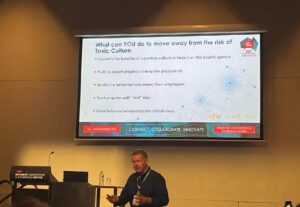
Chris O’Callaghan, Director of Consulting – HFW Consulting
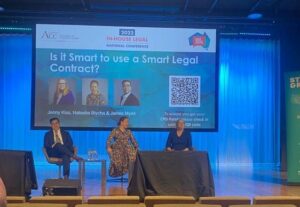
Jenny Kiss, Natasha Blycha and James Mynt – Stirling & Rose
The next 5-10 years will be an exciting time for technology, AI and the Metaverse, it’s important that in-house lawyers start to practically consider what changes they need to make and how they will adapt to the new technological environment.
A smart legal contract includes natural language (words/text) with code, and contractual obligations are defined and/or performed automatically by a computer program. Smart Legal Contracts collect data that is quantifiable, providing a single source of truth, and operate as a kind of ‘magic filing system’.
Requirements of a Smart Legal Contract:
While smart legal contract software is not yet readily available and accessible, in-house lawyers can start to prepare for the transition to Smart Legal Contracts by:
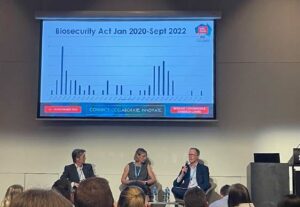
Stephen Bouwhuis, General Counsel in the Commonwealth Department of Health, Steve Webber, First Assistant Secretary Disputes and Corporate Law – Legal Group, Department of Home Affairs & Lisa Keeling, General Counsel – Australian Digital Health Agency
The pandemic placed enormous strain upon the legal capacity of the government. There were queues at CentreLink that went for kilometres and the MyGov website crashed, the ADF was deployed, and roles changed overnight. Media pressure was intense and eligibility criteria for payments was changing overnight.
Lawyers were redeployed across different areas; time frames were accelerated, and massive change happened incredibly quickly. There was forgiveness in not getting things perfect.
A separate legal team was established within the government to distribute and track legal work. It forced everyone to look at the larger system and adjust their risk appetite to the business risk appetite.
The legal teams were successful because they worked together as a team and “got on with things”. Networks and delegation became crucially important to avoid becoming overloaded and external law firms plugged many of the gaps, and they did it well, worked collaboratively.
Mental health is extremely important – it’s a marathon not a sprint, try to maintain a routine and watch for danger signs of mental health in you and your colleagues.
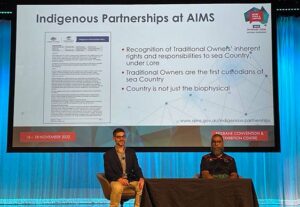
Andrew Paloni, Special Counsel – Major Projects at AIMS & Bob Muir, Indigenous Partnerships Coordinator at Australian Institute of Marine Science
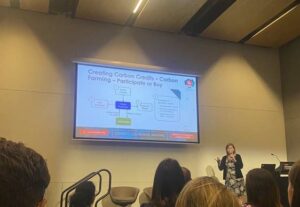
Suzanne Dickey, Senior Legal Counsel at Beach Energy
Emission reporting, carbon counting and ESG disclosure are becoming increasingly important for corporations. Regulatory bodies are cracking down on green-washing; shareholder activism is leading to litigation; and the nation tries to reach its net-zero emission targets by 2050. As in-house legal counsel, it’s important to stay on the forefront of these issues and understand how they affect your business.
The role of in-house counsel:
Mark Berridge, Author, Speaker and Lived Adversity Expert
“A Fraction Stronger” – book by Mark Berridge
Catherine McGregor AM, Writer, Commentator and former Australian Defence Force officer.
A broad ranging and poignant talk about leadership. The need to lead from the front – an Army Base in USA with a statute – inscribed with “Follow me”. Catherine examined the difference between management and leadership and shared many heartfelt examples of inspirational leadership she had witnessed in the ADF.
Good leadership can make a huge difference within an organisation.
As an example of how leadership can inspire Catherine recited St Crispin’s Day speech before the 1415 Battle of Agincourt by William Shakespeare, 1599:
But we in it shall be remembered –
We few, we happy few, we band of brothers;
For he to-day that sheds his blood with me
Shall be my brother; be he ne’er so vile,
This day shall gentle his condition;
And gentlemen in England now-a-bed
Shall think themselves accurs’d they were not here,
And hold their manhoods cheap whiles any speaks
That fought with us upon Saint Crispin’s day.
_______________________
Well done to the ACC Australia team and everyone involved. It was great to be back in person and enjoy another successful ACC National Conference!
Latest insight
We acknowledge the Traditional Custodians of Country throughout Australia and their connections to land, sea and community. We pay our respect to their Elders past and present and extend that respect to all Aboriginal and Torres Strait Islander peoples today.

All the in-house legal events this year in one place.


